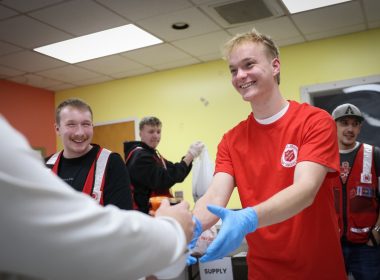DOING THE MOST GOOD
by Jeff Curnow –
If you haven’t seen it yet, you will! Doing the Most Good is the message and it is being carried coast to coast by The Salvation Army. During the coming months—using all the methods available—billboards, newspaper, magazines, radio, television, the internet and everyone involved in its work—the Army is introducing a national branding campaign.
Doing the Most Good is a promise that fully explains the motivation and methods of an Army doing so much that it has no time to tell its story—sometimes causing it to maneuver like a covert operations unit. By taking the time to reveal its grand campaign of battle, Doing the Most Good aims to fan the flames of the public’s love affair with the Army back to a roaring blaze.
Who Started the Fire?
During World War I, the simple doughnut, freely given to exhausted soldiers, gained The Salvation Army goodwill and publicity that no amount of money could buy. Immediately following the war, Evangeline Booth wrote in the foreword to her book, The War Romance of The Salvation Army:
“…there is no reward equal to that of doing the most good to the most people in the most need.”
Those simple doughnuts marked a shift in the public’s perception of the Army. Now the Army was taken seriously and lavished with affection. That perception continued for much of the last century. How many times have you heard a veteran say they give “to The Salvation Army because they helped me out and asked for nothing in return?”
These feelings about the Army have earned great dividends—more volunteers, public goodwill and greater donations—but warfare has changed. The ‘front lines’ are constantly shifting. As the generations of veterans who helped instill goodwill towards the Army in America’s subconscious ultimately pass on, who will tell the Army’s story?
Misinformation
Unfortunately, in the fast-paced 24-hour news environment in which messages are repeated with little thought of fact checking, the messenger who speaks the truth may not be heard. Instead, the messenger who answers more quickly and makes the most noise is granted credibility and regarded as an authority.
If we remain silent or passive, third party communicators—charity watchdog groups, web bloggers and special interest groups—will shape the public’s perception of The Salvation Army.
A big problem
Last December, when a tsunami devastated Sri Lanka, one national commentator proclaimed, “People shouldn’t donate to The Salvation Army for tsunami relief because it doesn’t have international experience.” One false comment like that can totally warp the public’s picture of the Army’s work (internationally—in 109 countries—and in Sri Lanka since 1883!) The public should know, instinctively, that such a statement is incorrect.
How does the Army educate the American public about all the services it provides? How does the Army make sure that it is giving the correct message in such a way that it drowns out those who are mistaken?
The Proactive Promise
Major George Hood, national community relations and development secretary, hopes that being proactive with our message will help. At a recent seminar introducing the Doing the Most Good branding promise, he implored, “We’ve been so passive and fragmented that we are on the brink of losing the connection we’ve had with the American public since World War I.”
The Army is going back to Evangeline Booth’s promise of “Doing the most good.” The campaign has been very successful in the Texas Division for the past two years. Says Hood, “It’s not just this year’s ad campaign, or a slogan with a new logo, it’s a promise—we promise that The Salvation Army will do the most good with the public’s resources, donations and trust. It is a bold statement, but it’s not a boast—no one is saying that we do things better than other caring organizations—we are making a solemn vow to the public that we will not betray its trust.”
Branding
It may seem strange or even somehow ignoble that this “Salvation” army should resort to marketing techniques, but like Nike or McDonald’s, The Salvation Army is already a brand. The Red Shield is one of the world’s most recognized logos. Focus groups (another marketing technique) show that the public truly loves our brand—they love the Army—yet amazingly, beyond Christmas kettles, thrift stores and a vague notion that the Army “does something to help the homeless,” almost no one could identify any specific services the Army performed!
That’s what the Doing the Most Good branding promise is about—stating, in the most direct and simple way, the essence of everything the Army does. As the promise is repeated, and lived out, the Army’s voice becomes stronger. The public will know what the Army’s position is and what it does. The motivation of The Salvation Army will no longer be open to interpretation—the Army is “Doing the Most Good.”









